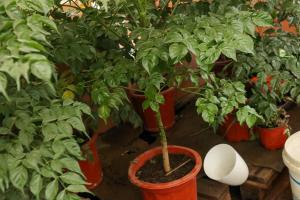Why Do Tomato Plant Leaves Turn Black?
One of the most satisfying aspects of growing tomatoes is watching the plant thrive and produce fruit. However, as every gardener knows, there are numerous challenges to growing healthy, productive tomato plants. Black leaves are one problem that many tomato growers face, and it can be frustrating to deal with. In this article, we'll explore the various reasons why tomato plant leaves turn black and offer some solutions to help you prevent or treat the problem.
Causes of Black Leaves in Tomato Plants
1. Fungal Diseases:?One of the most common reasons for black leaves in tomato plants is fungal diseases such as early blight, late blight, and septoria leaf spot. These fungi attack the leaves first and can cause them to turn black, then yellow and eventually fall off. Fungal spores can survive in the soil over winter and then infect the new plants in the spring. To prevent fungal diseases, you can water your plants in the morning and avoid getting water on the leaves. Also, avoid overcrowding your plants.
2. Overwatering:?Overwatering is another common cause of black leaves in tomato plants. When you water your plants excessively, the water accumulates in the soil and the roots soak in it for too long, leading to root rot. When the roots cannot absorb nutrients and water, the leaves turn black and die eventually. To avoid overwatering, only water your plants when the top 1-2 inches of soil are dry. Also, ensure proper drainage in your soil and use a moisture meter to test the soil before watering.
3. Nutrient Deficiencies:?Tomato plants require certain nutrients to thrive, and if these nutrients are lacking, the leaves can turn black. For example, if the plant is deficient in iron, the leaves can develop black spots that spread over the entire leaf. Similarly, calcium, phosphorus, and magnesium deficiencies can also cause black leaves. To avoid this problem, make sure your soil has a balanced concentration of nutrients and pH level.
Symptoms of Tomato Plant Leaves Turning Black
The symptoms of black leaves in tomato plants can vary depending on the cause. In the case of fungal diseases, the first sign is usually a black spot on the leaves, followed by yellowing and eventually falling off. Overwatering can cause the entire leaf to turn black, and the leaves may feel mushy to the touch. Nutrient deficiencies can cause black spots or streaks on the leaves, making them appear unhealthy.
How to Prevent or Treat Black Leaves in Tomato Plants
1. Proper watering:?Water your plants only when the soil is dry, and avoid getting water on the leaves. Use a moisture meter to test the soil before watering.
2. Fertilization:?Ensure that your soil has a balanced concentration of nutrients and pH levels. You can fertilize your plants with a balanced fertilizer or organic compost to provide the necessary nutrients.
3. Disease prevention:?To prevent fungal diseases, avoid overcrowding your plants and ensure proper ventilation. You can also use fungicides to treat fungal infections.
4. Pruning:?Prune the yellowing or infected leaves to prevent further spread of the disease.
5. Soil improvement:?In case of nutrient deficiencies, amend your soil with organic matter and fertilizers to improve the nutrient levels.
Conclusion
Black leaves in tomato plants can be caused by various factors, including fungal diseases, overwatering, and nutrient deficiencies. It is essential to identify the cause and apply the necessary treatments to prevent further damage. With proper care and attention, you can ensure healthy, productive tomato plants with vibrant green leaves.

 how many times do yo...
how many times do yo... how many planted tre...
how many planted tre... how many pine trees ...
how many pine trees ... how many pecan trees...
how many pecan trees... how many plants comp...
how many plants comp... how many plants can ...
how many plants can ... how many plants and ...
how many plants and ... how many pepper plan...
how many pepper plan...































